The Town Hall
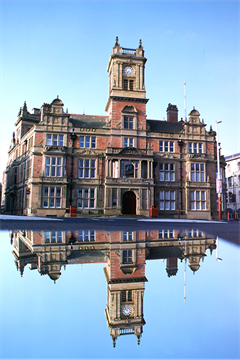 Messrs. Potts, Son and Hennings built the Town Hall between 1895 and 1900. The ground floor is of stone and the upper walls are of pink brick with stone dressings. There is a five-bay symmetrical front-centre project with round-arched entrance flanked by coupled and single pilasters with plain frieze and cornice. The first floor has a Venetian bay window with Ionic columns, frieze, cornice and curved pediment.
Messrs. Potts, Son and Hennings built the Town Hall between 1895 and 1900. The ground floor is of stone and the upper walls are of pink brick with stone dressings. There is a five-bay symmetrical front-centre project with round-arched entrance flanked by coupled and single pilasters with plain frieze and cornice. The first floor has a Venetian bay window with Ionic columns, frieze, cornice and curved pediment.
The second floor has double sash, and a square tower continues above the parapet, with a "cross" attic window, stone belfry and clock tower above with coupled pilasters and top balustrade parapet. Each side of centre has two six light cross-windows on the ground and first floors and two triple sashes on the top floor, with end bays rising into gabled attics.
The Corporation Street elevation has four bays, with a round-arched entrance, Jacobean windows, an oriel and a large round-headed Gothic traceried staircase window with stained glass. The rear facade has two oriels.
The Market Street facade is dated 1896 and has four oriels set in large round arches on the first floor, the ground floor has shop fronts. There are square downfall pipes and rainwater heads decorated with the letter 'B'. The interior has mosaic floors, coffered ceilings, and staircase with ornamental iron balustrade.
Stairway and entrance hall
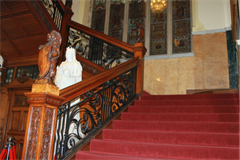 At the head of the stairway in the main entrance hall is a large and beautiful stained glass window, which was completed in 1900. The portrait of Queen Victoria shows her Crown over her veil, whereas in the Statue at the foot of the stairs the veil is over the crown in the form of a shroud. This was the practice to show that it was completed after the death of the sovereign e.g. 1904.
At the head of the stairway in the main entrance hall is a large and beautiful stained glass window, which was completed in 1900. The portrait of Queen Victoria shows her Crown over her veil, whereas in the Statue at the foot of the stairs the veil is over the crown in the form of a shroud. This was the practice to show that it was completed after the death of the sovereign e.g. 1904.
The window contains coats-of-arms from some of the towns and cities whose residents visited Blackpool and helped to make it into the popular resort of today. These are Bolton, Manchester, Liverpool, Bury, Oldham, Salford and Lancaster.
The harp of Ireland and the lion rampant of Scotland are also shown to indicate that people from those countries also visited Blackpool in large numbers. The Blackpool coat of arms is located centrally at the bottom of the window. This was granted by the College of Heralds on 10 June 1899.
The heraldic beasts depicted on the posts of the Stair banisters are purely decorative and have no particular significance.
The council chamber
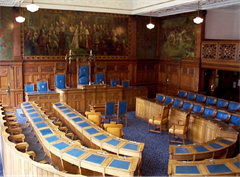 The council chamber was decorated to show Blackpool's association with the County Palatine of Lancaster and the area known as the Fylde. On the western side of the chamber are four windows, which were replaced in the 1940s following damage to the originals.
The council chamber was decorated to show Blackpool's association with the County Palatine of Lancaster and the area known as the Fylde. On the western side of the chamber are four windows, which were replaced in the 1940s following damage to the originals.
These represent the activities for which Blackpool is known education, light industry, agriculture and sport and recreation. Over in the public gallery is the original window from 1900 (in black and white) depicting a seaside scene, with shoreline, boats etc.
The mural paintings in the council chamber
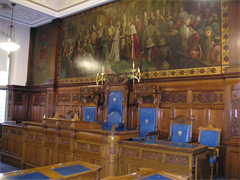 The paintings, which adorn three sides of the council chamber, are designed to illustrate the part taken by the Duchy and County of Lancaster in the making of England. The quarrel between the rival Royal houses of York and Lancaster, which resulted in the 30 years' civil War of the Roses, has furnished subjects for two of the paintings.Over the mayor's chair, a large picture typifies the reconciliation of the Yorkists and Lancastrians, representing, as it does, the marriage of King Henry VII of the House of Lancaster, to Princess Elizabeth of the House of York.
The paintings, which adorn three sides of the council chamber, are designed to illustrate the part taken by the Duchy and County of Lancaster in the making of England. The quarrel between the rival Royal houses of York and Lancaster, which resulted in the 30 years' civil War of the Roses, has furnished subjects for two of the paintings.Over the mayor's chair, a large picture typifies the reconciliation of the Yorkists and Lancastrians, representing, as it does, the marriage of King Henry VII of the House of Lancaster, to Princess Elizabeth of the House of York.
The wedding was solemnised at Westminster Abbey in January 1486 and rivalled the coronation ceremony, which it followed, in splendour. Care has been taken to represent as faithfully as possible the ecclesiastical and court costumes and usages of the time.The King is shown wearing his robe of Royal red and ermine tippet, and the bride the tall headdress with drooping veil, which, varying only in height and pointedness had been a feminine fashion for several reigns. The dresses of the ladies of the period were made very long and were trimmed with fur and embroidery.
The male costume was elegant the only noticeable extravagance being the long false sleeves, which are still a feature in municipal robes. The Garter King-at-Arms wearing his collar and ribbon of the garter, and carrying his baton of office, is a prominent figure to the left of the composition. The Archbishop of Canterbury, fully vested, wearing his pallium (the piece of white woollen cloth embroidered with nails fashioned in the form of a yoke, being a sign of his office) and having his pastoral cross behind him, joins the hands of the pair. He is attended by deacons, vested in dalmatics, one of whom holds an open service book richly illuminated.
The bishops, who lend dignity to the ceremony by their presence, carrying their crooks. Among them, as is shown, would stand the mitred Abbot of Westminster, who, independent of episcopal jurisdiction, ranked with the bishops. Backing the high altar,' which at that time would probably be more simply furnished with candles than is at present customary, is represented a tapestry woven with the history of the virgin.The stone screen, which forms the background to the scene, is that now existing, and dividing the chapel of Edward the Confessor from the choir and sacrarium.
Immediately behind the screen stands the coronation chair, with the sacred stone. Legend says it was that on which Jacob laid his head when he dreamt the dream of the ladder. Immediately behind Edward the Confessor's chapel was afterwards built that exquisitely beautiful dream in stone, which may be described as the acme of gothic architecture. The second picture, over the press and public platform, represents an event perhaps more closely connected with the Fylde district than is represented in the others - the surrender of the rebels at Preston in 1715. Upon the death of Queen Anne the sympathisers with the claims of the Chevalier de St. George (James Stuart, the brother of the deceased queen) made a disastrous attempt to place him upon the throne occupied by George I.
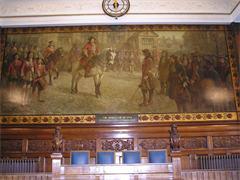 The rebellion was ill managed. The young and much beloved Earl of Derwentwater whose name still conjures up among the north country folks romantic regrets (he was a cousin of the exiled prince) took a prominent part in the rising, forced thereunto, it is said, by his countess. General Forster, a Northumbrian squire, totally devoid of military genius, was made the Commander-in-Chief and many noblemen and gentlemen joined the rebel ranks; but tile common people kept aloof. Quarrels arose between the Scots and English contingents, and at Preston, early in 1715, the rebel army surrendered to the royalist troops, under Generals Wills and Carpenter. The Earl of Derwentwater and many others were beheaded but General Forster escaped to the continent. It is related in Porter's "History of the Fylde" that Edward Tyldesley, of Fox Hall, Blackpool (the residence giving rise to the name of the present Foxhall Hotel) joined the rebels. For this act of treason he was put on trial, but escaped conviction and punishment through the favour of the jury, by whom he was acquitted in spite of clear and reliable evidence that he had entered Preston at the head of a company of insurgents, with a drawn sword in his hand. After the capitulation, when the king's troops had entered the town and were marching along the streets, many men from the Fylde district, who had congregated on Spital's Moss, armed with fowling pieces and implements of husbandry, joined their ranks, and a huge duck gun, belonging to a yeoman named Jolly, from Mythop near Blackpool, was instrumental in doing good service to the besiegers by slaying one Mayfield, of the Ashes, Goosnargh.
The rebellion was ill managed. The young and much beloved Earl of Derwentwater whose name still conjures up among the north country folks romantic regrets (he was a cousin of the exiled prince) took a prominent part in the rising, forced thereunto, it is said, by his countess. General Forster, a Northumbrian squire, totally devoid of military genius, was made the Commander-in-Chief and many noblemen and gentlemen joined the rebel ranks; but tile common people kept aloof. Quarrels arose between the Scots and English contingents, and at Preston, early in 1715, the rebel army surrendered to the royalist troops, under Generals Wills and Carpenter. The Earl of Derwentwater and many others were beheaded but General Forster escaped to the continent. It is related in Porter's "History of the Fylde" that Edward Tyldesley, of Fox Hall, Blackpool (the residence giving rise to the name of the present Foxhall Hotel) joined the rebels. For this act of treason he was put on trial, but escaped conviction and punishment through the favour of the jury, by whom he was acquitted in spite of clear and reliable evidence that he had entered Preston at the head of a company of insurgents, with a drawn sword in his hand. After the capitulation, when the king's troops had entered the town and were marching along the streets, many men from the Fylde district, who had congregated on Spital's Moss, armed with fowling pieces and implements of husbandry, joined their ranks, and a huge duck gun, belonging to a yeoman named Jolly, from Mythop near Blackpool, was instrumental in doing good service to the besiegers by slaying one Mayfield, of the Ashes, Goosnargh.
The rebel had secreted himself behind a chimney on one of the houses and was engaged in picking off the loyal soldiers as they made their way along the thoroughfare below. His murderous fire was at length put an end to by a charge from the famed gun of Jolly, whose keen eye had detected the assassin in his hiding place. Jolly himself appears to have had an aversion to causing the death of a fellow preacher in cold blood, even though a rebel, and the credit of the shot is due to a soldier whose own weapon failed in reaching the object. The Rev W Thornber, in his "History of Blackpool" remarks that the family of Jolly for many years treasured up the wonderful gun and that the tale of its exploit was circulated far and near.
The third picture, to the right of the mayor's chair, depicts the last desperate charge of Richard III. The doomed king is shown in full plate armour (copied from a magnificent suit in the Wallace collection at Hertford House, London) and wearing his tabard and his helmet surmounted by the crown of England and the "Cap of Maintenance".
The legend goes that after the death of Richard the crown was discovered in a bush and placed on the head of his rival, the Duke of Richmond (Henry of Lancaster) by Lord Stanley. The armorial bearings in the centre of each of the arabesque panels flanking the pictures are those of the several royal personages connected with the subjects of the pictures, viz., Elizabeth of York, Henry VII, Richard III, George I, and the Chevalier de St George (son of James II). The pictures, which are supplied by Messrs. Goodall, Lamb and Heighway, are the work of Mr J R Brown, of London, superintendent of their art department, and they do their creator lasting credit.
The general composition of the subjects has been studied with excellent effect, the prominent personages have been delineated with rare skill and knowledge and the treatment and colouring is as clever as it is captivating.
The mace
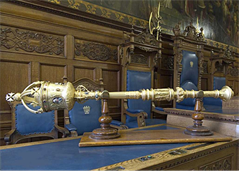 The Blackpool mace is of a most handsome and imposing appearance and enables Blackpool to claim the finest mace in the country. Councillor James Ward presented it to Blackpool in 1897 to commemorate the 60 years of reign by Queen Victoria and made its first appearance at a special meeting of the town council on 19 June 1897.
The Blackpool mace is of a most handsome and imposing appearance and enables Blackpool to claim the finest mace in the country. Councillor James Ward presented it to Blackpool in 1897 to commemorate the 60 years of reign by Queen Victoria and made its first appearance at a special meeting of the town council on 19 June 1897.
It weighs 131lbs and is 4ft 9ins high. It is set with real stones amethyst. Carbuncles and corals and is designed in the style of the finest ancient examples. The mace occupies its place of honour in front of the mayoral chair at council meetings. Health, Neptune as ruler of the ocean, Nemus as guardian of the waves, the shore and recreation are embossed in shells. Below this is a broad band representing the life of Blackpool- navigation, education, music, industry, steam, electric, progress, exercise and art. At either side of the head there are two beautiful enamel paintings of Her Majesty Queen Victoria, one of her at the time of her accession to the throne in 1837 and the other at the end of her 60 glorious years of reign.
History tells us that a mace was used in the Battle of Hastings in 1066 as a battle weapon. It is the emblem of authority and is used on all ceremonial occasions and always precedes the mayor. Actually the mayor himself should carry it but today mace-bearers are appointed. It is of the finest silver gilt. The chains worn by mayors and mayoresses have no special significance except to mark the wearers as persons of importance. The Blackpool mayoral chains were presented in the year 1876 when Blackpool received its Charter as a Borough.
Civic silver collection
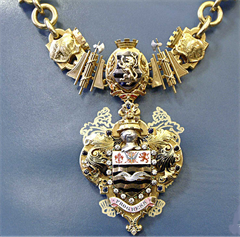 The council's civic silver collection has been built up through the years mainly by the generous gift of the various items to the council. The most notable of the pieces are, of course, the mayor's chain of office and pendant, the mayoress' chain of office and pendant and the mace. The mayor's chain of office was made in September 1876 and was first worn to a meeting of the council on 4 December 1897. The first Mayor, Alderman WH Cocker, donated it to the Council. The mayoress' chain of office was presented to the town by Alderman James Cardwell on 2 August 1877, to mark the queen's diamond jubilee Year. It was presented to the then mayoress, Mrs Ward, and succeeding mayoresses, in commemoration of the mayoralty of James Ward.
The council's civic silver collection has been built up through the years mainly by the generous gift of the various items to the council. The most notable of the pieces are, of course, the mayor's chain of office and pendant, the mayoress' chain of office and pendant and the mace. The mayor's chain of office was made in September 1876 and was first worn to a meeting of the council on 4 December 1897. The first Mayor, Alderman WH Cocker, donated it to the Council. The mayoress' chain of office was presented to the town by Alderman James Cardwell on 2 August 1877, to mark the queen's diamond jubilee Year. It was presented to the then mayoress, Mrs Ward, and succeeding mayoresses, in commemoration of the mayoralty of James Ward.
It was not until the early 1960s that it was decided to display suitable items from the collection in appropriate display cabinets. These are now located in the committee room ‘B’.
The mayor's parlour
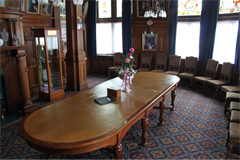 Over the centre of the door there is always a portrait of the current mayor, to the left is a photograph of the original crayon drawing of Doctor William Henry Cocker, dated 1876, the first mayor of the borough. The photographs move around clockwise each year and one is removed to make way for the new. To the side of the mayor's desk is a small cabinet containing the original town badge, which was donated by the Cocker family in 1876. The badge, which depicts a lifeboat, a sailing ship, a bathing hut and a pier, could not be described correctly in heraldic terms and was therefore never formally adopted as the Coat of Arms. Either side of the doorway are signed pictures of HM Queen Elizabeth II and His Royal Highness the Duke of Edinburgh taken in 1955 when the Royal Variety Show was held in the Opera House, Blackpool. On the right hand wall as you enter, there is a copy of a silver inscribed resolution of the council, which was sent to Queen Victoria to celebrate her 60th year on the throne. Other items of interest in the parlour include the twin town alcove, with various souvenirs from Bottrop, the silver Jubilee portrait of the Queen and Prince Phillip, a portrait of a famous freeman Sir Winston Churchill and several wall mounted items from the town's former adopted ships HMS Penelope, HMS Swiftsure and the recently adopted nuclear submarine HMS Splendid.
Over the centre of the door there is always a portrait of the current mayor, to the left is a photograph of the original crayon drawing of Doctor William Henry Cocker, dated 1876, the first mayor of the borough. The photographs move around clockwise each year and one is removed to make way for the new. To the side of the mayor's desk is a small cabinet containing the original town badge, which was donated by the Cocker family in 1876. The badge, which depicts a lifeboat, a sailing ship, a bathing hut and a pier, could not be described correctly in heraldic terms and was therefore never formally adopted as the Coat of Arms. Either side of the doorway are signed pictures of HM Queen Elizabeth II and His Royal Highness the Duke of Edinburgh taken in 1955 when the Royal Variety Show was held in the Opera House, Blackpool. On the right hand wall as you enter, there is a copy of a silver inscribed resolution of the council, which was sent to Queen Victoria to celebrate her 60th year on the throne. Other items of interest in the parlour include the twin town alcove, with various souvenirs from Bottrop, the silver Jubilee portrait of the Queen and Prince Phillip, a portrait of a famous freeman Sir Winston Churchill and several wall mounted items from the town's former adopted ships HMS Penelope, HMS Swiftsure and the recently adopted nuclear submarine HMS Splendid.
Description and heraldic significance of arms heraldic blazon
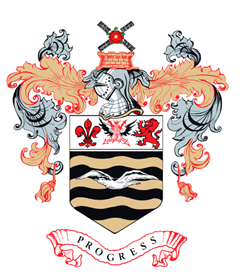 Barry wavy of eight sable and ora seagull volant proper, on a chief argent, a thunder-bolt also proper, between a fleur-de-lis and a lion rampant both gules, and for the crest on a wreath of the colours on the battlements of a tower or, the sails of a windmill saltirewise proper, surmounted in the centre by a rose gules barbed and seeded also proper. The field is composed of eight wavy bars alternately coloured black and gold. An old authority on heraldry states that "wavy" is supposed 10 represent waves and was originally used in the arms of those who distinguished themselves at sea. Thus, the black bars represent the waves of the sea at Blackpool and the golden bars the bright shining sands of the shore for which the town is noted.The "seagull-vol-ant-proper" means that the bird is depicted in the act of flying and its proper or natural colours as distinct from heraldic tinctures.
Barry wavy of eight sable and ora seagull volant proper, on a chief argent, a thunder-bolt also proper, between a fleur-de-lis and a lion rampant both gules, and for the crest on a wreath of the colours on the battlements of a tower or, the sails of a windmill saltirewise proper, surmounted in the centre by a rose gules barbed and seeded also proper. The field is composed of eight wavy bars alternately coloured black and gold. An old authority on heraldry states that "wavy" is supposed 10 represent waves and was originally used in the arms of those who distinguished themselves at sea. Thus, the black bars represent the waves of the sea at Blackpool and the golden bars the bright shining sands of the shore for which the town is noted.The "seagull-vol-ant-proper" means that the bird is depicted in the act of flying and its proper or natural colours as distinct from heraldic tinctures.
The significance of its position over the wavy bars is of course obvious. The chief, who is a division of the field at the upper part thereof and occupies one- third of the field in depth, is argent, or silver and bears three charges, namely: a fleur-de-lis, a thunderbolt and a lion rampant. The thunderbolt in the centre, which is emblazoned proper, is intended to allude to the enterprise of Blackpool as a pioneer in the adoption of electricity for lighting and traction purposes. The fleur-de-lis and the lion rampant, which are both gules (i.e. red) were distinguishing charges in the arms of the "Banks" and "Cocker" families respectively and their inclusion in the arms of the borough is meant to perpetuate the close association of those families with the early history of the town. As is generally the case, the crest is placed "on a wreath of the colours" by which is meant that the colours of the wreath, or the roll immediately above the helmet, are the same as those of the field, namely, black and gold.
The crest is composed of the battlements of a tower, gold, the sails of a windmill proper and a red rose, all represented in the device shown in the reprint. It has been suggested that the battlements of a tower are supposed to represent the idea of "corporateness", but in heraldry a tower is the emblem of grandeur and solidarity.The sails of a windmill, which are emblazoned proper and saltirewise that is, in the form of a diagonal cross, refer to " Fylde" a district in which Blackpool occupies a very important and prominent position. "Fylde" is an old word meaning "field", from which, it will be inferred that the district is chiefly devoted to agriculture, for which it has long held a high reputation. The Fylde formerly contained many windmills and does still retain a few for the grinding of com; quaint picturesque old landmarks which have for many years formed a peculiar and distinguishing feature of this countryside. It may also be said that the windmill sails allude to the health-giving breezes for which Blackpool is so well known.
The red rose in the centre of the windmill sails signifies the county in which the town is situate, that flower being the badge of the Plantagenets of the House of Lancaster and by the rose being "barbed and seeded proper" it is meant that the barbs (the outside petals of the heraldic rose) are represented green and the seeds (the centre of the heraldic rose) gold or yellow. Mantling in arms, shown in the reprints as the "decorative ornament" attached to the helmet, is held by some heralds to be merely an ornamental accessory; while other authorities believe it to have reference either to the mantle or "robe of estate" which in the middle ages was worn over the armour or to the flowing scarf which was attached to the helmet. One can understand this idea in connection with arms of individuals, but how can it be applied to the arms of a corporation is not quite clear.